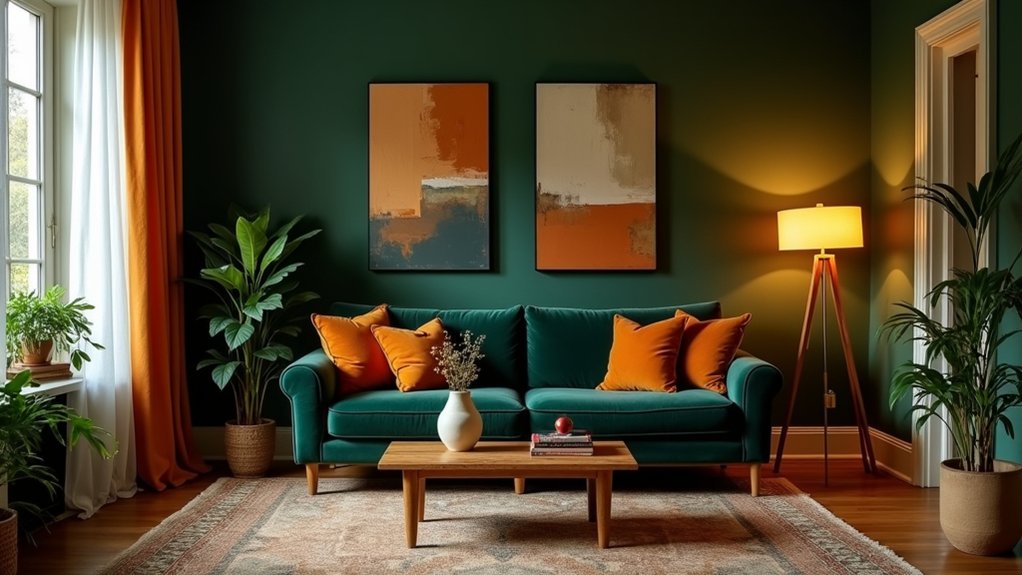
16 Dark Green and Burnt Orange Living Room Ideas That Are Earthy and Moody
A dark green and burnt orange living room achieves earthy elegance through saturated color contrasts, layered textures, and strategic lighting. Forest green walls or sofas anchor the space, complemented by burnt orange pillows, rugs, and terracotta accents that evoke warmth. Metallic copper or brass lighting and woven natural fibers heighten visual depth while potted greenery softens the palette. Neutral touches and reflective surfaces balance the moody ambiance. A wealth of curated ideas awaits for transformative, atmospheric design inspiration.
Key Takeaways
- Pair deep green walls with burnt orange accents for a moody, earthy color scheme that feels both sophisticated and inviting.
- Anchor the space with a forest green or burnt orange velvet sofa, adding warmth through textured pillows and chunky knit throws.
- Layer natural fiber rugs in green and rust tones to create cozy zones and enhance tactile depth.
- Use copper or gold lighting fixtures to add metallic warmth and amplify the intimate, autumnal ambiance.
- Incorporate terracotta pots and lush greenery to bring organic texture and contrast to the rich color palette.
Embrace Deep Green Walls With Burnt Orange Accents
When enveloping living room walls in deep green, the space acquires a sophisticated, moody ambiance that serves as an ideal canvas for burnt orange accents. This strategic color interplay leverages the depth of dark green as a backdrop, allowing burnt orange furnishings or decorative elements—such as abstract artwork, vases, or textured cushions—to punctuate the environment with warmth. The pairing draws from mid-century palettes, championing earthy tones for their timeless comfort and inviting aesthetic. Textiles in velvet or linen, particularly in burnt orange, introduce tactile variation, amplifying visual intrigue against matte or satin-finish green walls. To maintain chromatic equilibrium, integrating neutrals like wooden furniture or brushed metallics subtly grounds the room, ensuring the vibrant contrast remains cohesive, balanced, and visually compelling within the spatial composition. Additionally, incorporating geometric patterns can create rhythm and further enhance the overall design, adding a modern touch to the earthy and moody ambiance.
Pair a Forest Green Sofa With Rust-Colored Throw Pillows
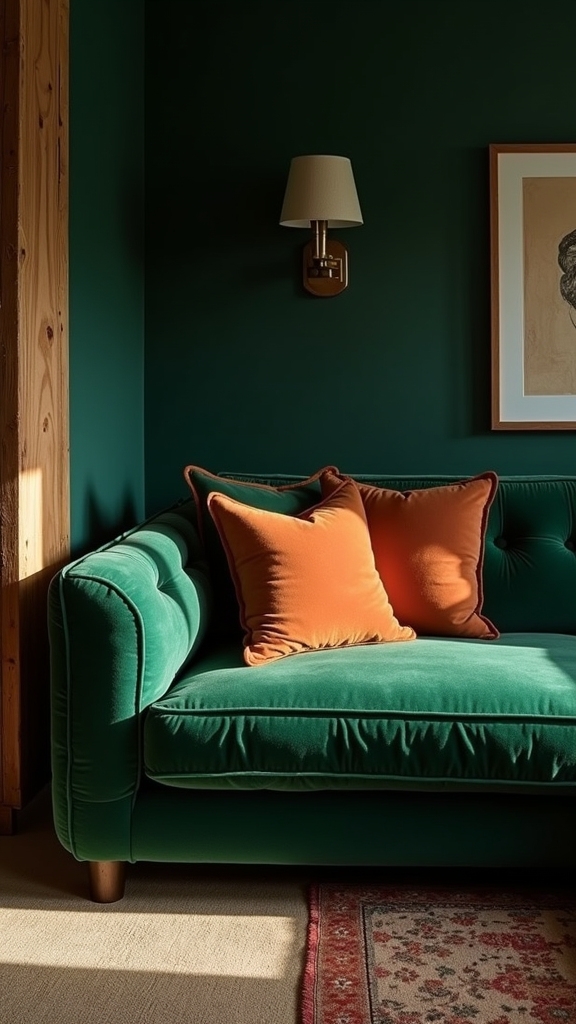
A forest green sofa anchors the room with saturated depth, while rust-colored throw pillows introduce dynamic contrast and visual warmth. The interplay of velvet or knitted textures within these accessories further enriches the tactile surroundings, inviting a layered and immersive experience. This arrangement establishes an autumnal ambiance, where bold hues and soft surfaces evoke comfort and seasonal nostalgia. Incorporating chunky knit throws on the sofa can further enhance the room’s cozier feel, adding another layer of warmth and texture to the space.
Balancing Bold Color Contrasts
By juxtaposing a forest green sofa with rust-colored throw pillows, the living room achieves a calculated interplay of saturated hues that both ground and enliven the space.
This deliberate use of complementary colors within the color palette promotes visual harmony while maintaining high-impact contrast, emblematic of earthy and moody interiors. The deep green acts as a stabilizing anchor, while the burnt orange injects radiant warmth, reminiscent of autumnal earth tones.
Strategic placement of these bold elements within the spatial composition fosters a curated environment with striking dimensionality.
- The forest green sofa serves as an immersive focal point, anchoring the color palette.
- Rust-colored pillows introduce complementary colors, enhancing visual depth.
- Autumnal earth tones evoke warmth and comfort, reinforcing the room’s inviting atmosphere.
- Bold contrasts are balanced through deliberate spatial arrangement and proportional distribution.
Enhancing Texture With Accessories
While the interplay of color sets the stage, it is texture that enriches the sensory experience of a living room anchored by a forest green sofa and rust-colored throw pillows.
Strategic use of textured pillows—such as those crafted from velvet, boucle, or chunky knits—introduces tactile variety, amplifying the visual depth in the space. These accessories not only reinforce the earthy theme but also emphasize the cozy atmosphere fundamental to this design scheme.
The plushness of layered textiles invites relaxation, while the juxtaposition of smooth and nubby surfaces guarantees dynamic spatial interest. Accents like woven throws or subtly patterned cushions further articulate the palette, connecting the moody green and burnt orange elements.
Creating Cozy Autumn Vibes
With textured accessories establishing tactile richness, the pairing of a forest green sofa with rust-colored throw pillows anchors the living room in autumnal warmth.
This deliberate composition of earthy tones—deep green and burnt orange—evokes the moody, layered vibrancy of autumn foliage.
Spatially, the sofa becomes the focal point, while rust pillows interject bursts of color and comfort.
Integrating natural textures, such as knitted throws or woven blankets, intensifies the cozy autumn vibes and enhances sensory depth.
The result is a space defined by visual warmth and inviting relaxation, ideal for communal gatherings or quiet evenings.
For a cohesive look, experts recommend incorporating additional organic elements:
- Wooden coffee tables or shelving
- Potted greenery for fresh contrast
- Woven baskets for storage
- Subtle metallic accents for balance
Layer Textured Rugs in Earthy Orange and Green Tones
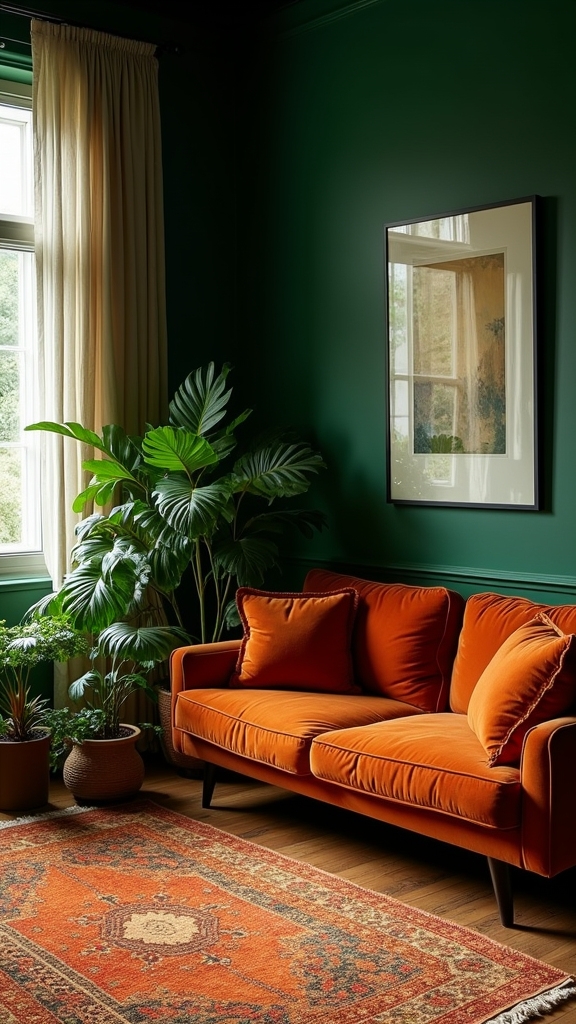
Strategically layering rugs crafted from natural fibers, such as jute and wool, introduces tactile complexity while reinforcing the organic palette of dark green and burnt orange.
Patterned textiles in varied shades of earthy orange and green accentuate warmth, visually linking disparate elements within the room.
This approach anchors the furniture layout, establishing defined zones and enhancing spatial cohesion.
Mix Patterned Natural Fibers
By layering textured rugs in earthy orange and green tones, a living room achieves enhanced spatial warmth and visual depth, especially when paired with dark green walls and burnt orange accents.
To maximize this effect, designers frequently mix patterned natural fibers—such as jute, wool, and cotton—to introduce tactile variety and subtle organic contrast.
The juxtaposition of patterns and solids in earthy tones establishes a cohesive design, visually delineating zones within the room while maintaining an inviting ambiance.
Varying the scale and geometric structure of each rug further softens the moody palette, underscoring the connection to nature.
- Select jute or wool rugs with intricate patterns for grounded visual interest
- Combine solid and patterned rugs to define spatial zones
- Emphasize earthy tones for organic harmony
- Layer rugs of varying sizes and shapes for dynamic spatial flow
Highlight Warm Color Layers
Building upon the interplay of patterns and natural fibers, the layering of textured rugs in earthy orange and green tones amplifies warmth and depth within the living room.
Expertly chosen layered rugs—such as a plush burnt orange rug beneath a flat-weave sage green accent—infuse the space with a warm undertone while cultivating tactile interest. The carefully selected earthy tones in these textiles harmonize with dark green walls and burnt orange furnishings, ensuring chromatic cohesion throughout the room.
Utilizing rugs crafted from natural fibers like jute or wool introduces visual and sensory complexity, reinforcing the room’s moody, organic ambiance.
Strategically layered rugs in contrasting colors can subtly demarcate functional zones, contributing to spatial organization and a holistic, inviting atmosphere in the living area.
Anchor Space With Rugs
A foundation of layered, textured rugs in earthy orange and green tones establishes both visual depth and spatial definition in a dark green and burnt orange living room.
Expertly selected rugs featuring natural fibers, such as jute or wool, introduce tactile richness and amplify warmth within the overall color palette. The interplay between burnt orange and sage green area rugs not only grounds the space but also accentuates the room’s moody atmosphere.
Patterned and textured layers further unify the scheme, lending cohesion to a dynamic and inviting living area. Strategic placement of rugs guarantees a harmonious progression between vibrant hues and earthy tones, balancing boldness with comfort.
- Combine burnt orange and sage green rugs for bold contrast
- Choose natural fiber rugs for warmth and texture
- Layer varying patterns to enhance visual cohesion
- Use rugs in earthy tones to ground the color palette
Create a Moody Ambiance With Copper and Gold Lighting
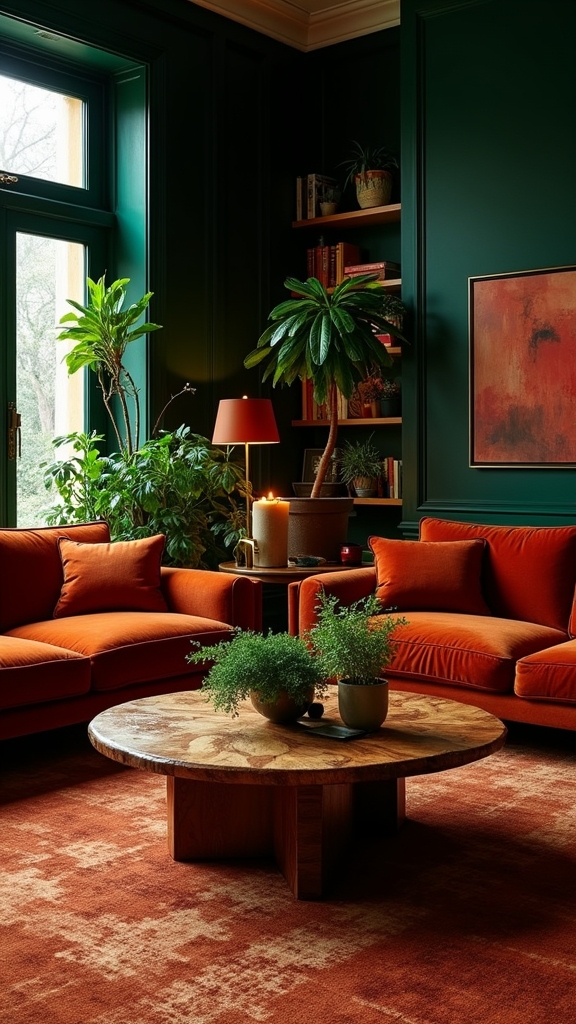
When copper and gold lighting fixtures are introduced into a living room adorned with dark green and burnt orange, the interplay of metallic warmth against deep, earthy hues produces an atmosphere that is both intimate and visually compelling. These fixtures function as both luminous sources and sculptural decor, their reflective surfaces amplifying the moody ambiance established by dark green walls. Strategic placement of ambient and accent lighting creates layers of illumination, accentuating key architectural features and highlighting art or furnishings. The juxtaposition between the rich pigment of the walls and the lustrous tones of copper and gold establishes dynamic visual tension, contributing to a space that feels both grounded and sophisticated. Textured or uniquely shaped fixtures reinforce the earthy aesthetic, unifying the room’s design narrative. Incorporating soft ambient lighting can further soften shadows and enhance the warm, inviting atmosphere in the room.
Incorporate Terracotta Planters and Lush Greenery
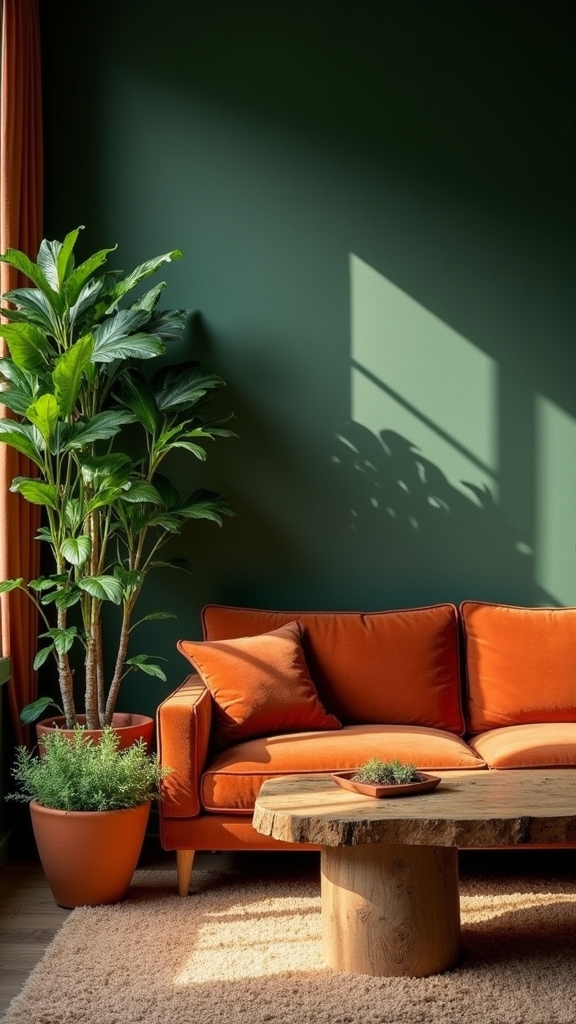
Terracotta pots introduce tactile warmth and organic color, anchoring the visual palette of dark green and burnt orange interiors.
Strategically layering leafy botanicals of varying heights and textures enhances spatial depth, while the interplay between cool green foliage and the room’s warm tones generates striking contrast.
This arrangement not only reinforces cohesion but also imparts dimensionality and natural vibrancy to the living space.
Elevate With Terracotta Pots
Strategically placed terracotta planters introduce an earthy counterpoint to the dark green and burnt orange palette, amplifying the room’s warmth through their rustic hue and tactile texture.
Terracotta pots, with their unglazed surfaces and organic coloration, ground the space within an earthy touch that resonates harmoniously with a moody color palette.
By varying pot sizes and heights, depth and visual rhythm are established, enhancing the interplay between architecture and organic elements.
The contrast of verdant foliage against the burnt orange and deep green further accentuates the vibrancy of each hue, ensuring spatial cohesion and dynamic visual interest.
- Terracotta pots emphasize the autumnal tone of the living room.
- Warm clay hues enhance a moody color palette.
- Layered arrangements foster spatial depth and movement.
- Lush greenery in terracotta planters invigorates the atmosphere.
Layer Varied Leafy Plants
Building upon the foundational influence of terracotta planters, an artful layering of varied leafy plants further enriches the visual and sensory environment of the living room. Within this setting, lush greenery not only enlivens the moody tones of a green palette and burnt orange accents, but also reinforces the earthy narrative through diverse botanical forms. The strategic placement of layered plants—such as trailing pothos, upright ferns, and broad-leafed philodendrons—introduces both verticality and depth. Terracotta’s rustic warmth contrasts with verdant foliage, amplifying spatial interplay and natural cohesion. Plants of differing heights and textures create a dynamic oasis effect, enhancing air quality while providing a tactile, restorative atmosphere.
| Layered Element | Visual Impact |
|---|---|
| Tall Ferns | Vertical emphasis |
| Trailing Pothos | Cascading movement |
| Philodendrons | Broad, lush density |
| Terracotta Planters | Earthy, warm foundation |
| Mixed Textures | Depth and visual intrigue |
Contrast Warm and Cool
When deep green walls and burnt orange accents converge, the interplay of warm and cool tones can be heightened by the judicious use of terracotta planters and vibrant greenery.
Terracotta introduces earthy tones that ground the palette, while lush foliage—ferns or snake plants—intensifies the visual contrast against burnt orange features.
The spatial arrangement of planters in varying heights and widths adds depth and dynamic layering. This strategy accentuates the natural synergy between green and burnt orange, reinforcing an organic, moody atmosphere without overwhelming the senses.
Ideal placement of greenery softens bold contrasts and guarantees the living room remains harmonious and inviting.
- Terracotta planters introduce tactile, earthy tones
- Varied planter sizes create spatial rhythm and visual depth
- Lush greenery enlivens and contrasts burnt orange accents
- Strategic placement fosters balance within the color contrast
Style a Burnt Orange Velvet Couch With Dark Green Decor
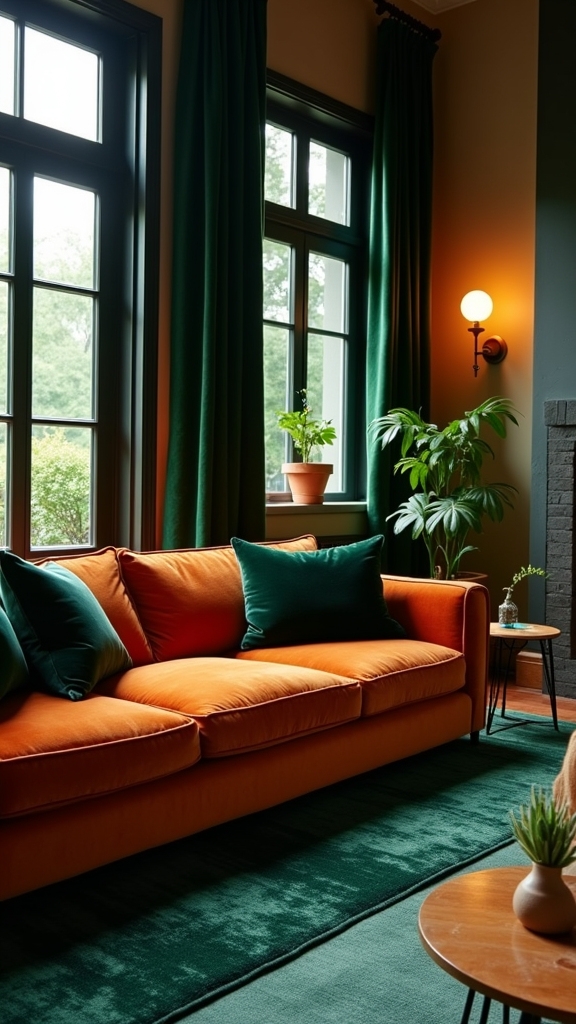
Set against a backdrop of deep green, a burnt orange velvet couch commands attention as the living room’s definitive focal point, anchoring the space with bold, earthy warmth.
This dynamic interplay between the burnt orange living room centerpiece and enveloping dark green decor establishes a sophisticated, moody palette. Employing deep green accent walls or curated accessories amplifies the velvet’s richness, cultivating an immersive, earthy ambiance.
Natural materials—think tactile wooden furnishings and terracotta vessels—layer in organic depth while echoing the room’s rooted character. Textural diversity, achieved through plush throws or patterned cushions in complementary hues, enhances visual intrigue and comfort.
Incorporating natural materials such as wood and rattan not only adds warmth but also complements the earthy tones of both the burnt orange and dark green elements, creating a cohesive and inviting atmosphere.
Subtle gold or brass accents, strategically positioned, inject an understated elegance, harmonizing with the earthy tones and elevating the overall spatial composition.
Use Olive Green and Burnt Orange in a Mid-Century Setting

While olive green and burnt orange are emblematic of mid-century modern interiors, their dynamic interplay achieves a vibrant yet grounded atmosphere ideal for contemporary living rooms. This pairing, with 13.3k mentions in design discussions, leverages the retro palette’s inherent warmth and sophistication.
Olive green’s muted undertones anchor spaces, while burnt orange infuses energy through accent pieces or curated artwork. Mid-century silhouettes—defined by clean lines and organic forms—are enhanced by these hues, fostering both visual cohesion and spatial balance.
Olive green grounds the room as burnt orange accents bring vibrancy, creating harmony and balance within iconic mid-century modern forms.
- Olive green sofas or accent chairs set the foundation for vintage authenticity.
- Burnt orange cushions, rugs, or wall art punctuate the space with warmth.
- Geometric patterns and streamlined mid-century forms amplify design synergy.
- Terra cotta or natural material accessories reinforce an earthy, cohesive palette.
Showcase Wooden Furniture With Warm Orange Hues
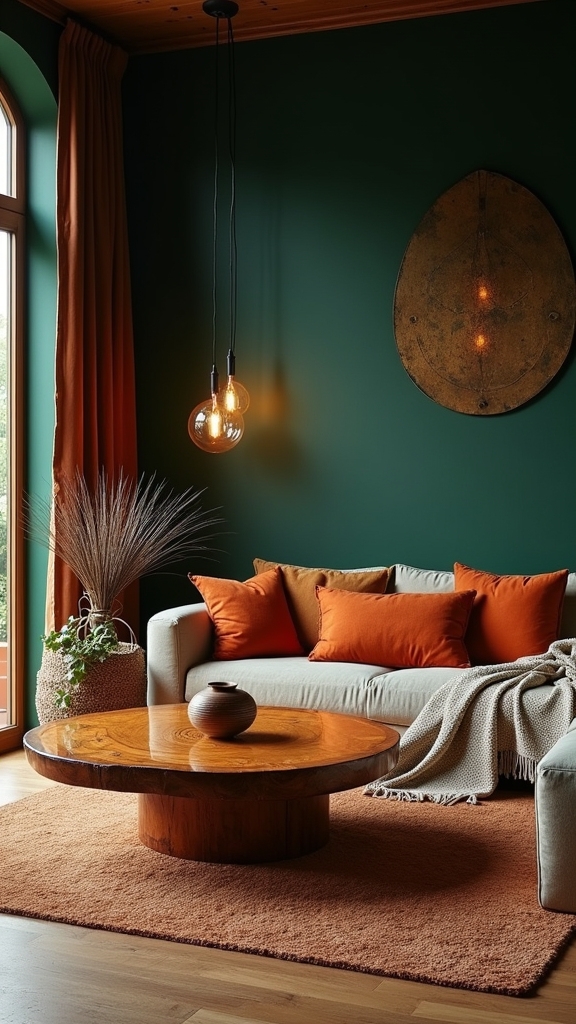
Building upon the retro-inspired interplay of olive green and burnt orange, wooden furniture in warm orange hues introduces a tactile sophistication to the living room. The organic grain of oak or walnut, finished in subtle burnt orange tones, forms a seamless dialogue with dark green walls, establishing spatial cohesion and visual warmth. Strategically placing a burnt orange accent chair or a wooden coffee table with a matte orange finish creates a dynamic focal point, anchoring the seating area while enhancing the earthy palette. Textured wooden furniture not only reinforces the rustic yet modern aesthetic but also layers depth and dimensionality into the space. Accessories such as side tables in complementary hues further unify the design, ensuring the shift between dark green and burnt orange remains harmonious and visually compelling. Incorporating exposed wooden beams in the ceiling adds rustic charm and structural elegance, further enhancing the living room’s cohesive and inviting atmosphere.
Add Dramatic Contrast With Dark Green Paneling
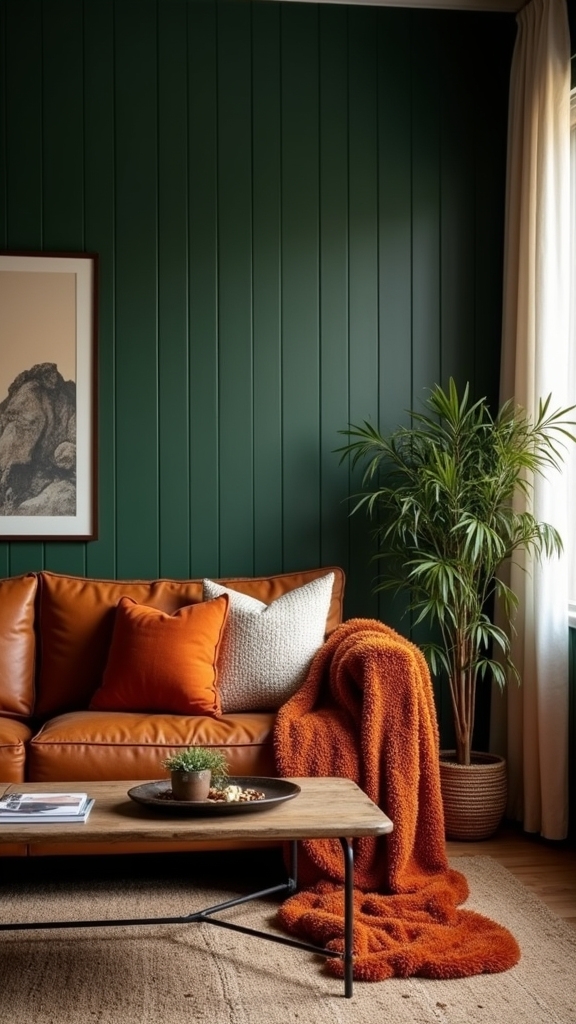
Paneling in a deep, saturated green establishes a striking architectural foundation that instantly enhances the living room’s visual drama. Dark green paneling not only anchors the space but also creates a dynamic interplay with burnt orange accents, reinforcing the earthy and moody character of the interior.
The enveloping effect of forest green on the walls or as wainscoting provides a backdrop where burnt orange furnishings become sculptural focal points. Integrating natural elements and tactile finishes guarantees the palette feels inviting, not overwhelming. For added refinement, metallic details introduce glimmers of sophistication. Utilizing neutral furniture such as beige, gray, or white can complement the vivid green and burnt orange without overwhelming the space.
- Dark green paneling delivers architectural gravitas and a moody ambiance.
- Burnt orange upholstery or décor pops vividly against green, creating focal contrast.
- Wooden textures infuse warmth, softening the bold scheme.
- Metallic accents—gold or brass—inject subtle luxury and depth.
Highlight a Statement Wall in Burnt Orange Paint
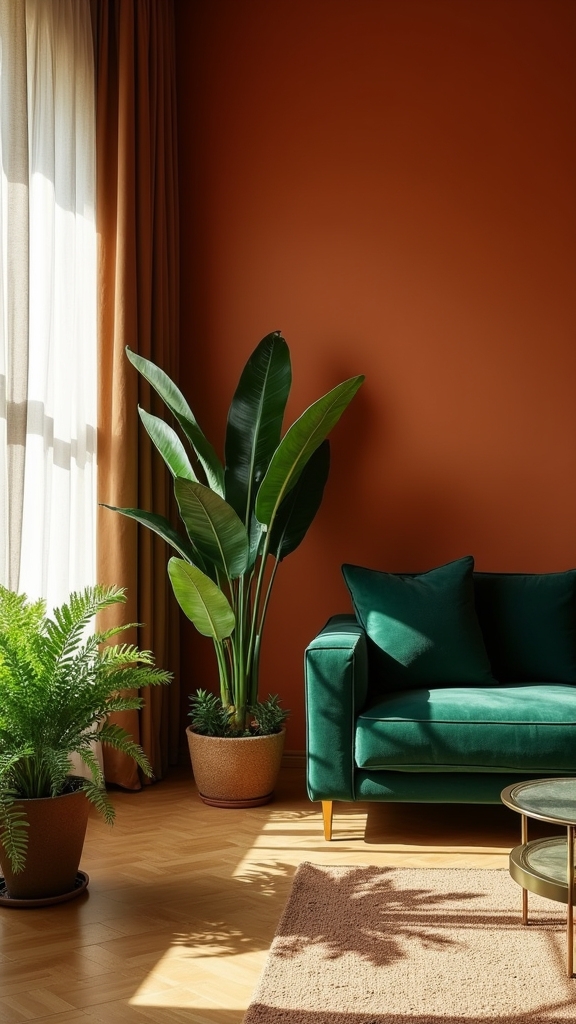
When a living room is defined by dark green tones, introducing a statement wall in burnt orange instantly commands attention, orchestrating a striking visual anchor within the space.
The juxtaposition of the saturated burnt orange against enveloping dark green walls infuses the room with warmth and a dynamic sense of depth, while reinforcing an earthy, moody aesthetic.
This statement wall, particularly effective in mid-century and bohemian contexts, enhances spatial definition and creates a central focal point without overwhelming the environment.
Burnt orange’s versatility allows for seamless integration with tactile materials such as wood, leather, and metallic finishes, further elevating the room’s cohesion.
To temper the bold contrast, neutral furnishings in beige or cream subtly ground the palette, ensuring the statement wall remains prominent yet harmonious.
Incorporating layered illumination techniques can further enhance the warmth and functionality of the space by creating a cohesive atmosphere with ambient, accent, and task lighting.
Mix Sage Green Accents With Rich Burnt Orange Throws
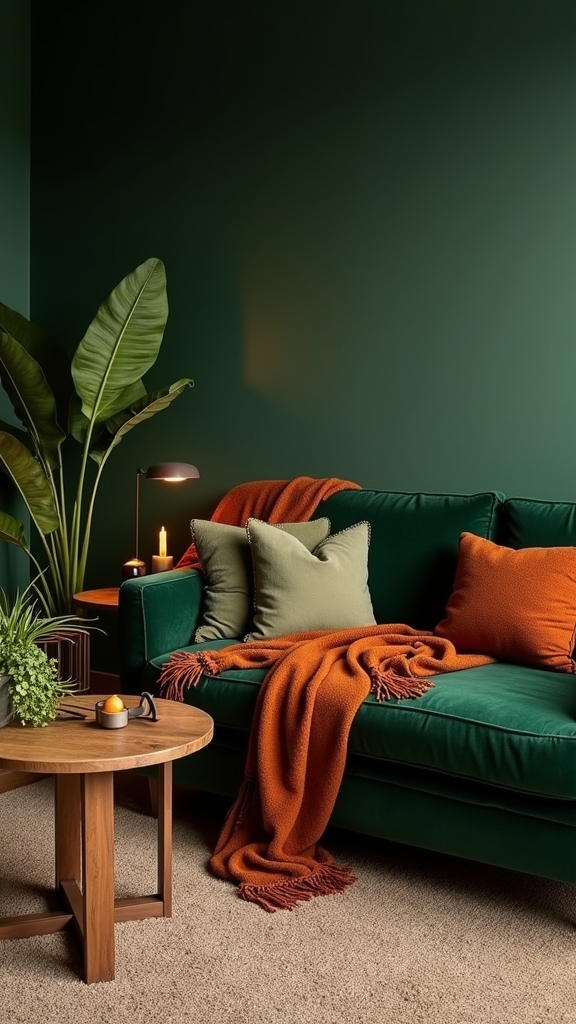
Strategic layering of sage green accents with rich burnt orange throws introduces multidimensional warmth, capitalizing on both tactile and chromatic contrast.
Soft textiles, such as plush throws and velvet cushions, counterbalance bold color saturation, fostering visual equilibrium within the spatial composition.
This interplay of muted and vivid elements enhances depth while maintaining a cohesive, inviting atmosphere.
Layering Textures for Warmth
Infusing a dark green living room with warmth and depth is achieved by layering diverse textures—specifically, draping rich burnt orange throws over sage green accent pillows. This expert approach capitalizes on the interplay between tactile surfaces and saturated hues, creating a multidimensional, moody ambiance.
Layering textures, such as velvet and chunky knit, enhances visual and tactile engagement, while the contrast between burnt orange and sage green punctuates the space with vibrant yet grounded energy. Opting for natural fibers like wool and cotton further underscores the earthy, organic motif, amplifying comfort and inviting relaxation.
The spatial placement of these elements draws the eye across the room, establishing a cohesive yet distinctly cozy environment.
- Velvet sage green pillows for plushness
- Burnt orange wool throws for warmth
- Chunky knit textures for added depth
- Natural cotton accents for breathability
Balancing Soft and Bold
Deliberately juxtaposing sage green accents with rich burnt orange throws introduces a dynamic equilibrium between softness and boldness in the living room’s palette.
A green sofa, upholstered in muted sage, serves as a tranquil anchor, while tactile burnt orange throws punctuate the seating area with saturated warmth. This interplay of earthy tones leverages sage green’s neutrality to temper the vibrancy of burnt orange, ensuring visual balance rather than chromatic competition.
Layering plush textiles—such as velvet cushions or chunky knit blankets—on the green sofa further amplifies the sense of comfort and tactile richness.
The spatial arrangement allows burnt orange elements to act as intentional focal points, while gold accents enhance the overall composition, fostering a cohesive, sophisticated, and inviting ambiance ideal for earthy, moody interiors.
Display Autumnal Art for a Cozy, Seasonal Feel
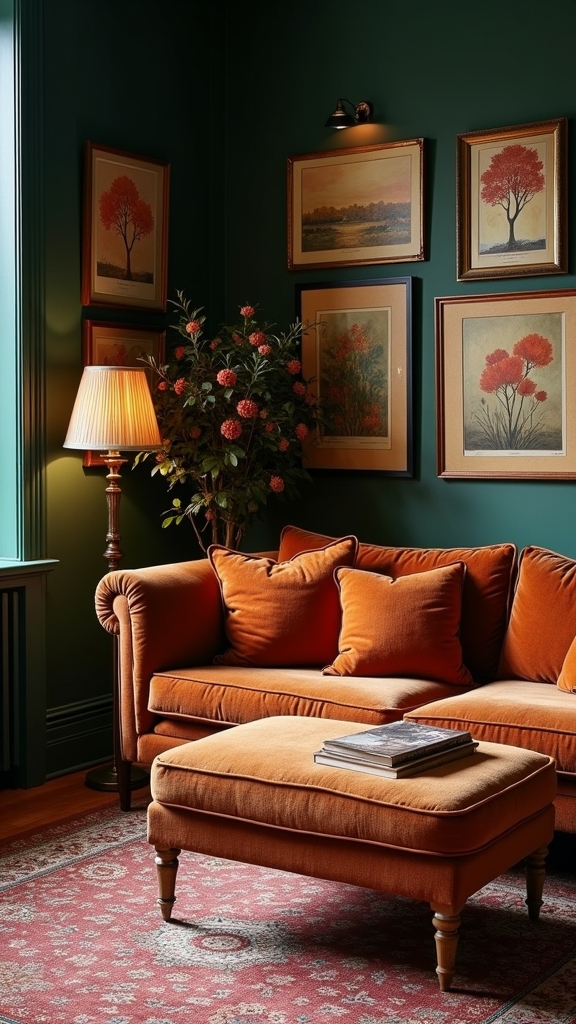
Autumnal artwork acts as a visual anchor within a dark green and burnt orange living room, reinforcing the space’s moody, enveloping palette. Curated autumnal art imbues the interior with earthy tones, echoing the natural changes of the season and amplifying the cozy atmosphere.
Strategically placed pieces—landscapes of fall foliage, harvest motifs, or abstract compositions in rust and olive—forge a harmonious link between the dominant hues. Textured frames in rich wood or metallic finishes add dimensionality, while rotating seasonal pieces guarantees visual freshness.
Landscapes in autumnal hues and textured frames create harmony, while rotating seasonal art keeps the space feeling fresh and inviting.
The result is an intentional gallery wall or focal vignette that envelops inhabitants in warmth and comfort. To further enhance the warm ambiance, incorporate lighting techniques such as layered lighting and strategically positioned accent lights.
- Highlight autumnal art featuring earthy tones and natural motifs
- Incorporate wood or metallic textured frames for added depth
- Rotate artworks seasonally for dynamic visual interest
- Position art to maximize cozy atmosphere and spatial harmony
Blend Green Boho Patterns With Orange Retro Elements
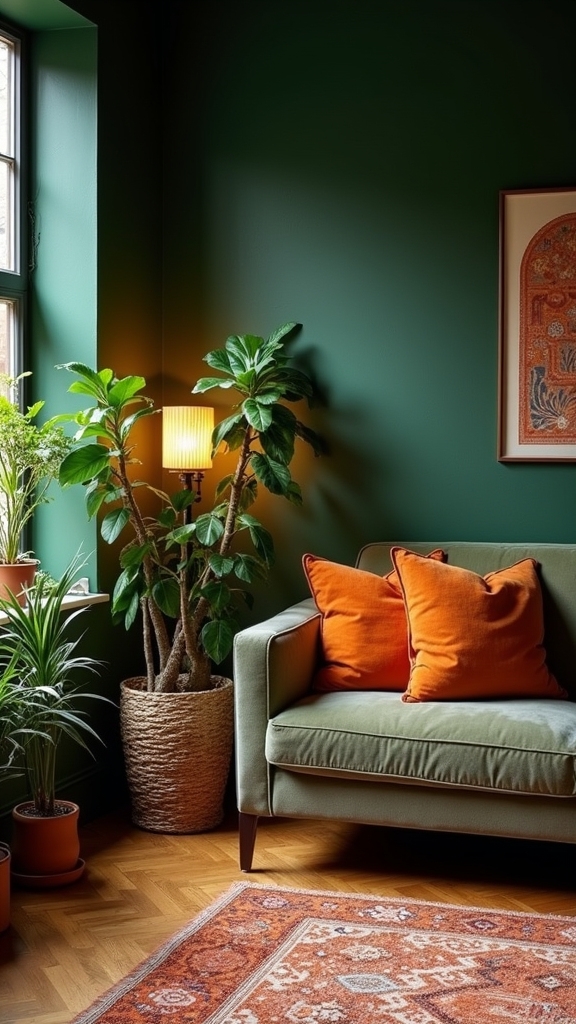
When green boho patterns intersect with burnt orange retro elements, the living room transforms into a layered tableau of color and texture. Expertly curated, this juxtaposition leverages the vibrancy of green boho patterns—often found in patterned textiles like throw pillows and area rugs—to set a visually stimulating foundation. Burnt orange retro furnishings, such as velvet armchairs or modular sofas, introduce a nostalgic warmth, anchoring the palette with a bold yet inviting presence. Earthy textures, including rattan, jute, or weathered wood, further articulate depth and tactile richness, fostering a cohesive interplay between organic and geometric motifs. Incorporating natural elements and greenery can further enhance the bohemian vibe, creating a vibrant indoor space that connects with nature. Natural materials and flowing, organic furniture silhouettes guarantee spatial harmony, celebrating both the relaxed ethos of bohemian style and the structured appeal of mid-century retro design.
Accent With Brass Fixtures and Earthy Textiles
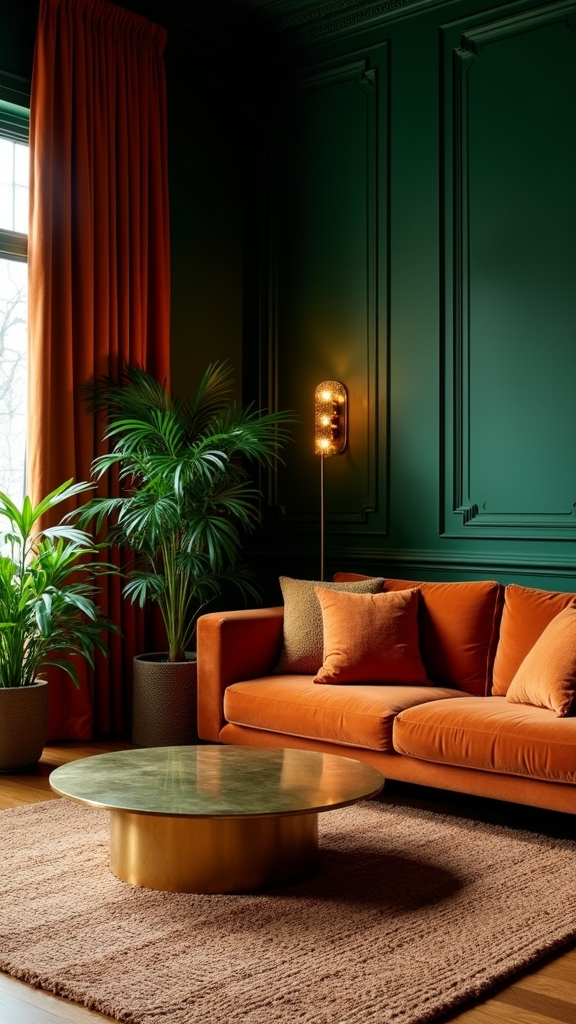
Enhance the interplay of dark green and burnt orange by integrating brass fixtures and earthy textiles, establishing both visual contrast and cohesion within the living room.
Brass fixtures introduce sophisticated metallic warmth that punctuates the moody palette, while earthy textiles such as linen, jute, and velvet reinforce a cozy atmosphere.
Brass fixtures add metallic warmth, while earthy textiles like linen, jute, and velvet envelop the living room in inviting comfort.
The layering of tactile fabrics with metallic elements guarantees depth and spatial harmony, preventing the rich colors from appearing flat or overwhelming.
Brass light fixtures or decorative vases serve as luminous focal points, drawing the eye and grounding the space.
- Brass light fixtures amplify elegance and reflect ambient lighting.
- Earthy textiles like linen and jute infuse tactile comfort and texture.
- Velvet cushions in burnt orange add plushness and dimensionality.
- Woven natural fiber rugs anchor the color scheme and enhance spatial flow.
Decorative storage solutions like curated books and baskets can further enhance the aesthetic appeal of your living room, adding both practicality and style to the space.
Use Green and Orange Color Blocking for Modern Impact
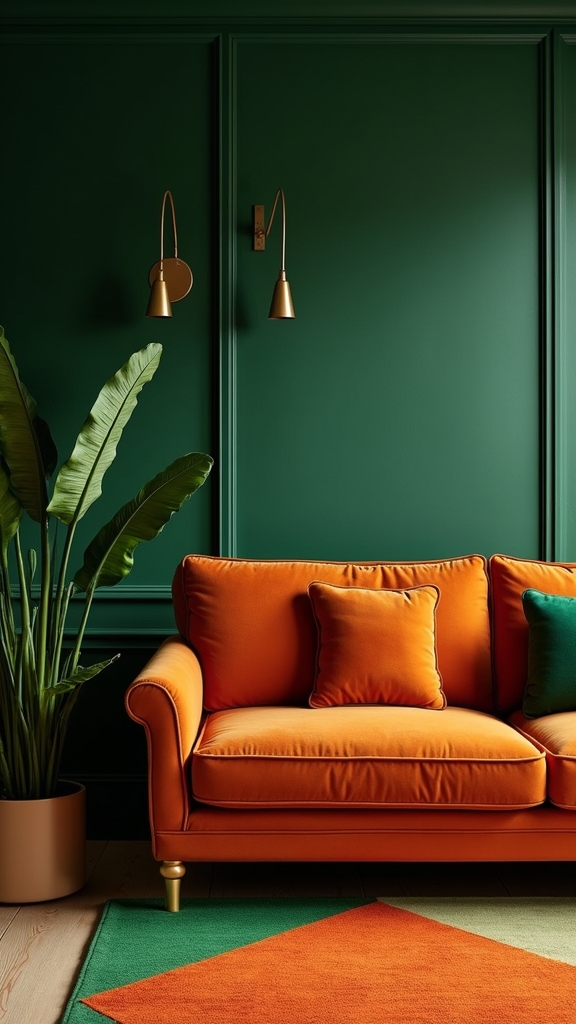
A considered application of color blocking with dark green and burnt orange infuses the living room with modern dynamism and distinct zoning.
Strategic placement of large blocks—such as a burnt orange sofa juxtaposed against a green color accent wall—establishes clear visual boundaries, enhancing spatial clarity and cohesion.
Designers favor muted iterations of both hues, tempering the intensity for a harmonious, earthy ambiance that remains visually impactful yet welcoming.
The interplay of textures, like plush burnt orange velvet paired with sleek green fabrics, amplifies depth and tactile richness within the color blocking scheme.
Metallic accents in gold or brass further punctuate the palette, introducing a layer of sophistication without overshadowing the primary tones.
This approach results in a living room that is both contemporary and inviting.
Balance Moody Tones With Natural Light and Neutrals
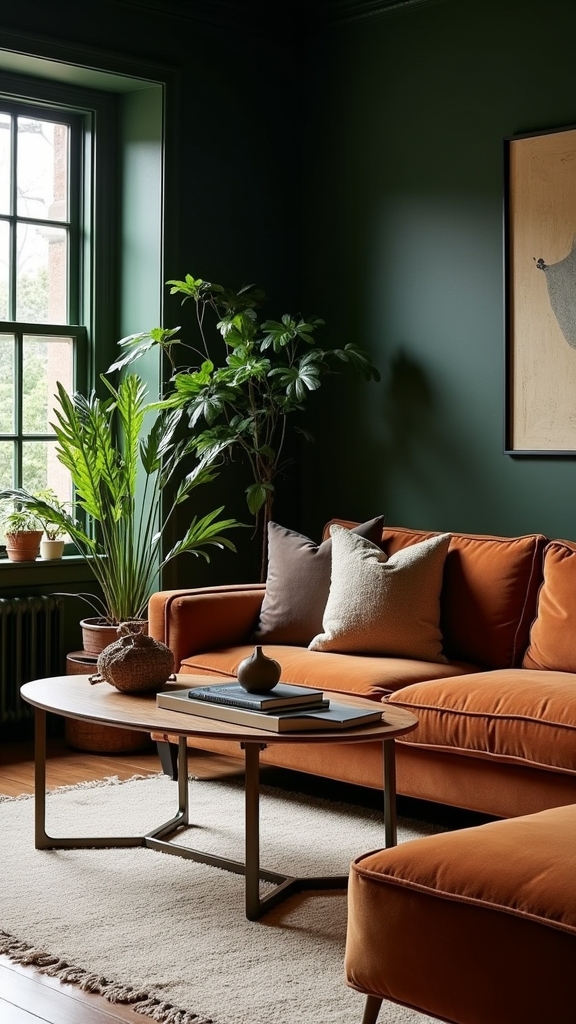
Many living rooms featuring dark green and burnt orange benefit from an intentional interplay of moody tones, natural light, and neutrals to achieve spatial equilibrium.
The infusion of natural light through expansive windows or glass doors alleviates the visual weight of saturated hues, ensuring the room remains open and inviting.
Employing neutral elements—such as white or beige furnishings—introduces essential negative space, which accentuates the vibrancy of dark green and burnt orange.
Layered textures, like light textiles and organic materials, soften the intensity while amplifying the tactile experience.
Strategically positioned mirrors further optimize brightness by reflecting natural light throughout the space.
- Incorporate large windows to maximize daylight exposure
- Use white or beige furniture to introduce neutral elements
- Layer light fabrics and natural materials for warmth
- Place mirrors to enhance spatial luminosity and depth
Frequently Asked Questions
Do Burnt Orange and Dark Green Go Together?
When considering color psychology, burnt orange and dark green harmonize through their warm tones, invoking comfort and liveliness. This earthy palette creates visual depth and spatial balance, making it a sophisticated combination for layered, inviting interior environments.
What Colors Go With a Burnt Orange Living Room?
For a burnt orange living room, designers recommend integrating sage green, terracotta, and mustard yellow for harmonious earthy color palettes. Neutral tones and metallic finishes complement burnt orange accents, cultivating visually balanced, cozy living spaces with enhanced spatial depth.
What Is the Complementary Color of Green and Orange?
According to color theory, green’s complementary color is red, while orange’s is blue. Utilizing these pairings enables mood enhancement and spatial balance, especially in nature-inspired palettes, where visual emphasis and contrast are essential for dynamic, harmonious environments.
What Colour Goes With Dark Green in Living Room?
When considering what colour pairs with dark green in a living room, designers recommend integrating dark green accents with warm neutral tones, such as taupe or beige, while featuring vibrant artwork to create visual interest and enhance spatial balance.
Conclusion
A dark green and burnt orange living room masterfully balances depth with vibrancy. Utilizing expert color blocking, layered textiles, and metallic highlights, interiors achieve both earthy grounding and moody sophistication. Spatial arrangement of terracotta planters, brass fixtures, and textured rugs defines zones while enhancing visual flow. Thoughtful interplay of natural light and deep hues prevents heaviness, ensuring an inviting ambiance. The result is a harmonious, visually compelling space that exudes warmth, modernity, and organic elegance.
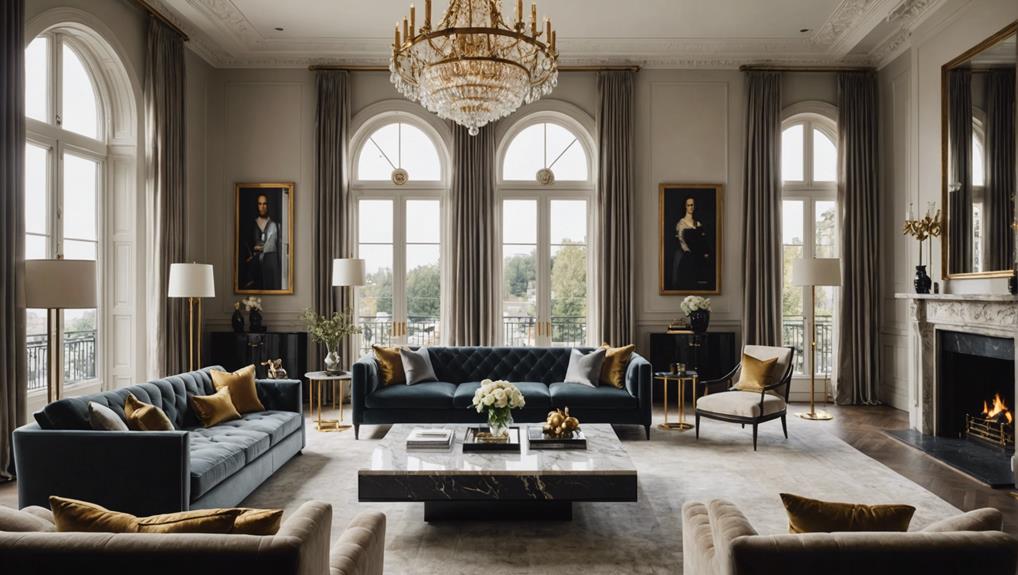
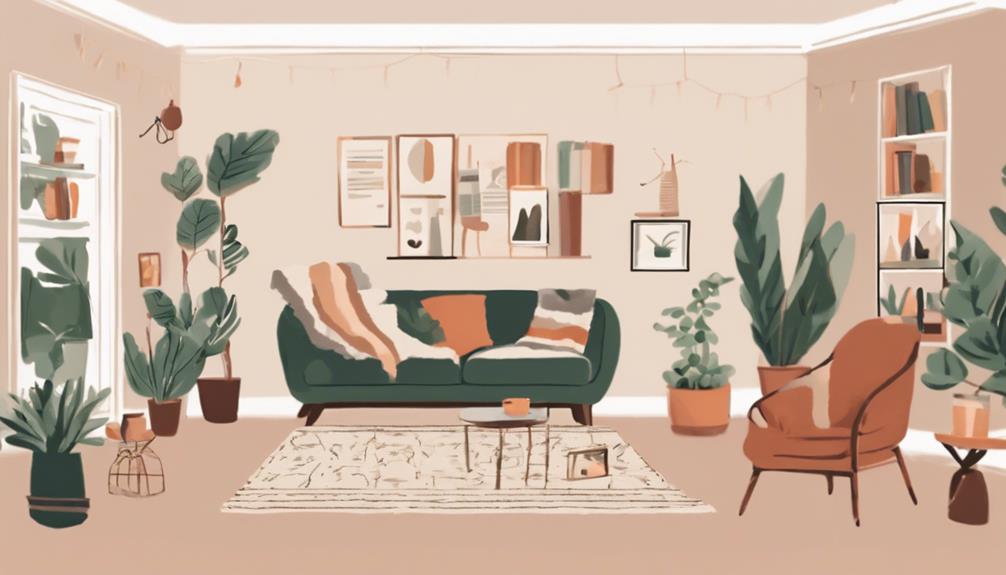
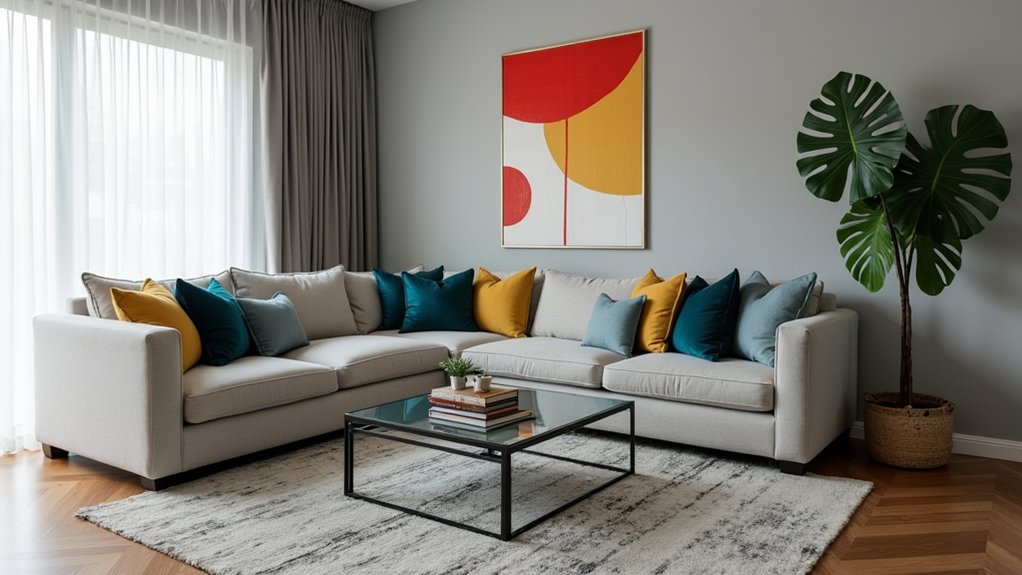
Leave a Reply